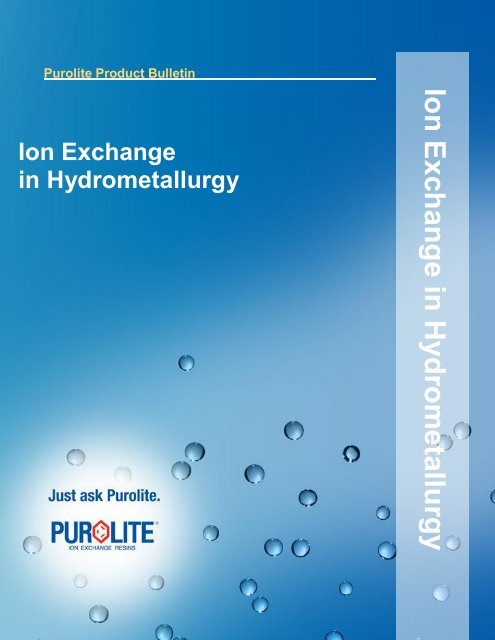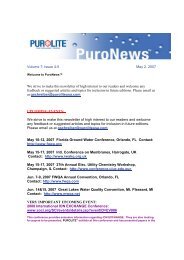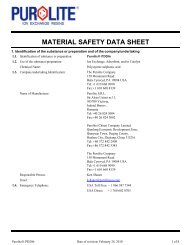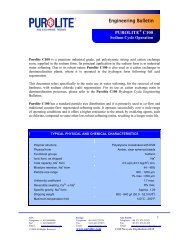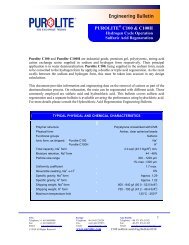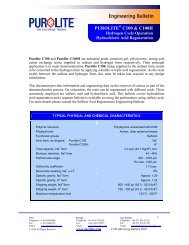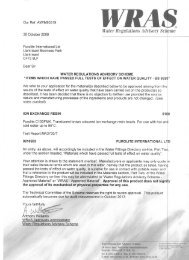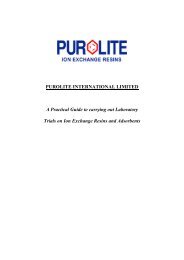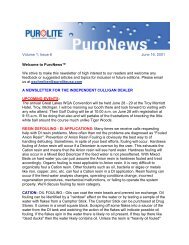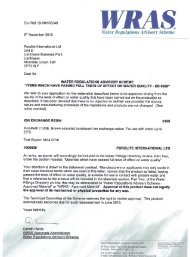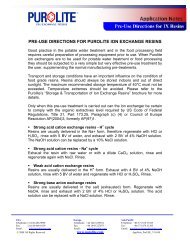Ion exchange in hydrometallurgy - Purolite.com
Ion exchange in hydrometallurgy - Purolite.com
Ion exchange in hydrometallurgy - Purolite.com
You also want an ePaper? Increase the reach of your titles
YUMPU automatically turns print PDFs into web optimized ePapers that Google loves.
<strong>Purolite</strong> Product Bullet<strong>in</strong> Hydrometallurgy<br />
<strong>Purolite</strong> Product Bullet<strong>in</strong>_________________________<br />
<strong>Ion</strong> Exchange<br />
<strong>in</strong> Hydrometallurgy<br />
Hydrometallurgy 09 2012 0<br />
<strong>Ion</strong> Exchange <strong>in</strong> Hydrometallurgy
<strong>Purolite</strong> Product Bullet<strong>in</strong> Hydrometallurgy<br />
Hydrometallugy<br />
Metals can be extracted from ores us<strong>in</strong>g several<br />
methods. They can be extracted us<strong>in</strong>g chemical<br />
solutions (Hydrometallurgy), us<strong>in</strong>g heat<br />
(Pyrometallurgy) or us<strong>in</strong>g mechanical means.<br />
Hydrometallurgy is the process of extract<strong>in</strong>g<br />
metals from ores by dissolv<strong>in</strong>g the ore<br />
conta<strong>in</strong><strong>in</strong>g the metal of <strong>in</strong>terest <strong>in</strong>to an aqueous<br />
phase and recover<strong>in</strong>g the metal from the<br />
result<strong>in</strong>g pregnant liquor.<br />
Hydrometallurgy often offers the most costeffective<br />
and environmentally friendly techniques<br />
for extract<strong>in</strong>g and concentrat<strong>in</strong>g different metals.<br />
Often, various hydrometallurgical processes are<br />
used <strong>in</strong> the same flowsheet, such as <strong>com</strong>b<strong>in</strong><strong>in</strong>g<br />
ion <strong>exchange</strong> and solvent extraction for the<br />
recovery and purification of uranium.<br />
Hydrometallurgical processes can also be<br />
<strong>com</strong>b<strong>in</strong>ed with non - hydrometallurgical<br />
extractive metallurgy processes.<br />
Table 1 - Applications of ion <strong>exchange</strong> <strong>in</strong> <strong>hydrometallurgy</strong><br />
Orig<strong>in</strong> of stream to be treated <strong>Ion</strong> <strong>exchange</strong> application<br />
This bullet<strong>in</strong> discusses the use and advantages<br />
of ion <strong>exchange</strong> res<strong>in</strong>s for sorption and recovery<br />
of target metals.<br />
1. Applications of <strong>Ion</strong> Exchange (IX)<br />
<strong>Ion</strong> <strong>exchange</strong> technology is used for the primary<br />
recovery of metal(s) of <strong>in</strong>terest or the removal of<br />
specific impurities <strong>in</strong> order to <strong>in</strong>crease the value<br />
and purity of the f<strong>in</strong>al product.<br />
A wide variety of process streams benefit from<br />
the application of ion <strong>exchange</strong> res<strong>in</strong>s, as shown<br />
<strong>in</strong> Table 1.<br />
2. <strong>Ion</strong> Exchange Contactor Design<br />
<strong>Ion</strong> Exchange contactor designs are quite<br />
diverse and customized. They generally fall <strong>in</strong>to<br />
three categories: Fixed Bed, Fluidized Bed and<br />
Res<strong>in</strong> <strong>in</strong> Pulp. The design varies as a function<br />
of the properties of the medium be<strong>in</strong>g treated<br />
and overall capital expense optimization<br />
considerations.<br />
<strong>Ion</strong> <strong>exchange</strong> contactors perform two key<br />
functions:<br />
1. They provide conditions that favor<br />
efficient mass transfer between the<br />
process solution or pulp and the ion<br />
<strong>exchange</strong> res<strong>in</strong><br />
2. They ensure the efficient mechanical<br />
separation of the ion <strong>exchange</strong> res<strong>in</strong><br />
from the solution or pulp.<br />
Ore, after heap or agitated leach Primary recovery of metal(s) of <strong>in</strong>terest, e.g. gold, uranium<br />
Volatile <strong>com</strong>pounds captured <strong>in</strong> offgases<br />
from smelters and roasters<br />
Slags and calc<strong>in</strong>es from roast<strong>in</strong>g and<br />
smelt<strong>in</strong>g operations<br />
Electrolyte<br />
Tail<strong>in</strong>gs treatment<br />
Acid m<strong>in</strong>e dra<strong>in</strong>age<br />
Recovery of rhenium from off-gases produced by roast<strong>in</strong>g of<br />
molybdenite and smelt<strong>in</strong>g of copper concentrates<br />
Recovery of various metal(s) of <strong>in</strong>terest, after leach<strong>in</strong>g<br />
Removal of copper and z<strong>in</strong>c impurities from cobalt and nickel<br />
advance electrolytes, to ensure higher metal purity<br />
Recovery of copper, cobalt, gold, etc from historical m<strong>in</strong>e<br />
tail<strong>in</strong>gs, as well as current aris<strong>in</strong>gs<br />
Treatment of process water to enable recycl<strong>in</strong>g to the plant or<br />
safe disposal<br />
Hydrometallurgy 09 2012 1
<strong>Purolite</strong> Product Bullet<strong>in</strong> Hydrometallurgy<br />
An important factor that determ<strong>in</strong>es the design<br />
of an ion <strong>exchange</strong> contactor is the suspended<br />
solids content of the pregnant liquor/pulp. A<br />
certa<strong>in</strong> quantity of suspended particles is always<br />
present <strong>in</strong> the actual pregnant solutions from<br />
which the metal(s) of <strong>in</strong>terest is to be recovered.<br />
A suitable ion <strong>exchange</strong> contactor design must<br />
be selected based on the suspended solid<br />
content <strong>in</strong> a pregnant flow, as summarized <strong>in</strong><br />
Table 2.<br />
Table 2 - Choice of IX contactor based on<br />
solids content of feed<br />
Solids content<br />
Clear liquid, Pb 2+ > Zn 2+ > Cd 2+ ><br />
Ni 2+ > Ca 2+<br />
Phosphonic res<strong>in</strong>s: Cu 2+ > Zn 2+ > Cd 2+ > Mn 2+<br />
> Co 2+ > Ni 2+ > Ca 2+<br />
Am<strong>in</strong>ophosphonic res<strong>in</strong>s (at acidic pH): H + ><br />
Fe 3+ > Pb 2+ > Cu 2+ > Zn 2+ , Al 3+ > Mg 2+ ≥ Ca 2+ ≥<br />
Cd 2+ > Ni 2+ ≥ Co 2+ > Na +<br />
Im<strong>in</strong>odiacetic res<strong>in</strong>s: Cr 3+ > In 3+ > Fe 3+ > Al 3+<br />
> Hg 2+ > UO 2+ > Cu 2+ > Pb 2+ > Ni 2+ > Cd 2+ > Zn 2+<br />
> Co 2+ > Fe 2+ > Mn 2+ > Ca 2+ > Mg 2+<br />
Strong acid res<strong>in</strong>s: Fe 3+ > Ca 2+ > Fe 2+ > Cu 2+<br />
> Mg 2+ > K + > NH4 + > H +<br />
Strong base res<strong>in</strong>s: SO4 2- > CO3 2- > NO3 - > Cl -<br />
- - -<br />
> HCO3 > F > OH<br />
Bis-picolylam<strong>in</strong>e res<strong>in</strong>s: Cu 2+ > Ni 2+ > Fe 3+ ><br />
Zn 2+ > Co 2+ > Cd 2+ > Fe 2+ > Mn 2+<br />
Hydrometallurgy 09 2012 3
<strong>Purolite</strong> Product Bullet<strong>in</strong> Hydrometallurgy<br />
The usual <strong>com</strong>plement of parameters that are to<br />
be controlled dur<strong>in</strong>g production <strong>in</strong>cludes:<br />
� Functionality: determ<strong>in</strong>es the selectivity<br />
of the res<strong>in</strong> for certa<strong>in</strong> metals over<br />
others<br />
� <strong>Ion</strong> <strong>exchange</strong> capacity: a high capacity<br />
is desirable to reduce the size of the<br />
plant and subsequently the cost of<br />
capital <strong>in</strong>vestment and elution reagents<br />
� Grad<strong>in</strong>g: smaller beads are used <strong>in</strong> fixed<br />
bed operations, which benefits from the<br />
improved k<strong>in</strong>etics of smaller beads. RIP<br />
operations require larger beads, to allow<br />
for ease of separation of the res<strong>in</strong> and<br />
pulp.<br />
� Mechanical stability<br />
� Osmotic stability<br />
All the characteristics of IX res<strong>in</strong>s are<br />
<strong>in</strong>terdependent and performance of the res<strong>in</strong> is a<br />
trade-off between the different technical<br />
parameters of the res<strong>in</strong>.<br />
4. Pr<strong>in</strong>ciples of Res<strong>in</strong> Volume Estimation for a<br />
specific project<br />
In order to make an <strong>in</strong>itial estimate of ion<br />
<strong>exchange</strong> plant size, it is necessary to calculate<br />
the res<strong>in</strong> volume that is sufficient to reach the<br />
performance target. This is calculated from the<br />
mass balance equation for the target metal:<br />
Mass balance: CPLS × FPLS = CR × FR<br />
CPLS: Metal concentration <strong>in</strong> PLS, kg/m 3 (PLS)<br />
FPLS: Flow rate of PLS, m 3 (PLS)/hr<br />
CR: Operat<strong>in</strong>g metal capacity of the res<strong>in</strong>,<br />
kg/m 3 (R)<br />
FR: Flow rate of the res<strong>in</strong>, m 3 (R)/hr<br />
IX res<strong>in</strong> flow rate: FR = (CPLS × FPLS)/CR<br />
Total Res<strong>in</strong> Inventory (m 3 ):<br />
VR = FR × (T1 × k + T2 + T3)<br />
T1 – Residence time at sorption provided that:<br />
� The concentration of the metal is<br />
reduced to the tail limits (e.g., < 5 ppm<br />
for most uranium projects).<br />
� The metal capacity of the res<strong>in</strong> reaches<br />
maximum.<br />
A res<strong>in</strong> "safety" volume should be provided for<br />
the sorption stage; for this volume, the Т1<br />
parameter should be multiplied by a k factor with<br />
a value of 1.1 – 1.5 (the process-designer<br />
selects the actual value).<br />
T2 – Residence time at desorption<br />
T3 – Residence time <strong>in</strong> auxiliary operations<br />
By m<strong>in</strong>imiz<strong>in</strong>g FR and T, CAPEX can be<br />
reduced.<br />
In order to m<strong>in</strong>imize FR a res<strong>in</strong> must have a<br />
maximum capacity.<br />
In order to m<strong>in</strong>imize T1, a res<strong>in</strong> must have the<br />
best ion <strong>exchange</strong> k<strong>in</strong>etics.<br />
In order to m<strong>in</strong>imize T2, a res<strong>in</strong> must have<br />
efficient desorption; i.e., <strong>com</strong>plete and rapid.<br />
In order to m<strong>in</strong>imize T3, the desorption and<br />
regeneration processes must be simple, so as to<br />
avoid or m<strong>in</strong>imize additional operations.<br />
Hydrometallurgy 09 2012 4
<strong>Purolite</strong> Product Bullet<strong>in</strong> Hydrometallurgy<br />
5. Select<strong>in</strong>g the Optimum Res<strong>in</strong><br />
There are a number of important considerations<br />
<strong>in</strong> choos<strong>in</strong>g the correct res<strong>in</strong>. They <strong>in</strong>clude:<br />
� The target metal. Is it a valuable metal(s)<br />
or an impurity?<br />
� The matrix. e.g. acidic (sulfate, chloride,<br />
etc.) or alkal<strong>in</strong>e (cyanide, sodium<br />
carbonate, etc.)<br />
� The solution pH. The performance of IX<br />
res<strong>in</strong>s can be affected by pH.<br />
� Recovery from pulp (RIP) or clear solution<br />
Res<strong>in</strong> <strong>in</strong> Solution (RIS). This will<br />
determ<strong>in</strong>e the type of contactor required,<br />
as well as dictate certa<strong>in</strong> physical<br />
properties of the res<strong>in</strong> (size, physical<br />
strength).<br />
� Presence of <strong>com</strong>pet<strong>in</strong>g ions. It is important<br />
to choose a res<strong>in</strong> with a high selectivity for<br />
the metal of <strong>in</strong>terest.<br />
� The solution temperature. While <strong>in</strong>creased<br />
temperatures generally benefit most<br />
reactions, IX res<strong>in</strong>s are temperature<br />
sensitive and for hydrometallurgical<br />
applications a maximum operat<strong>in</strong>g<br />
temperature of 60 °C is usually<br />
re<strong>com</strong>mended.<br />
� Integration with other unit operations. i.e.<br />
the choice of elution reagent is often<br />
dictated by requirements/limitations of<br />
downstream processes.<br />
� Process flexibility. Is it possible to change<br />
the pH of the solution to possibly benefit<br />
the IX unit operation while hav<strong>in</strong>g a<br />
m<strong>in</strong>imal impact on the rest of the circuit?<br />
� Environmental limitations. The choice of<br />
elution/regeneration reagents is <strong>in</strong>fluenced<br />
by regulations on the disposal thereof.<br />
Table 3 shows a number of<br />
hydrometallurgical applications and the<br />
suggested <strong>Purolite</strong> res<strong>in</strong>(s)<br />
Table 3 - Hydrometallurgical Application and the suggested <strong>Purolite</strong> res<strong>in</strong>(s)<br />
Target metal Detail <strong>Purolite</strong> ® res<strong>in</strong>(s)<br />
Gold Cyanide liquors and pulps<br />
Purogold A193<br />
Purogold S992<br />
Gold Thiosulphate leach <strong>Purolite</strong> ® A500/2788, <strong>Purolite</strong> ® A530<br />
Gold Acidic liquors or pulps <strong>Purolite</strong> ® S920, <strong>Purolite</strong> ® S924<br />
Plat<strong>in</strong>um Group Metals Acidic liquors or pulps<br />
<strong>Purolite</strong> ® S920, <strong>Purolite</strong> ® S924,<br />
<strong>Purolite</strong> ® S985<br />
Molybdenum Acidic liquors or pulps <strong>Purolite</strong> ® A100Mo<br />
Rhenium Acidic liquors or pulps<br />
<strong>Purolite</strong> ® A170/4675,<br />
<strong>Purolite</strong> ® A172/4635<br />
Gallium Recovery from Bayer solutions <strong>Purolite</strong> ® S970<br />
Rare Earth Elements Acidic liquors or pulps<br />
Copper, nickel, cobalt, z<strong>in</strong>c Acidic liquors or pulps<br />
Nickel Acidic liquors or pulps <strong>Purolite</strong> ® S960<br />
Copper & z<strong>in</strong>c impurity<br />
removal<br />
Cobalt and nickel electrolyte <strong>Purolite</strong> ® S950<br />
Selection of cation <strong>exchange</strong><br />
res<strong>in</strong>s<br />
<strong>Purolite</strong> ® S930Plus,<br />
<strong>Purolite</strong> ® S930/4884, <strong>Purolite</strong> ® S960<br />
Mercury Various liquors and waste waters <strong>Purolite</strong> ® S920, <strong>Purolite</strong> ® S924<br />
Antimony Various liquors and waste waters <strong>Purolite</strong> ® S957<br />
Bismuth Various liquors and waste waters <strong>Purolite</strong> ® S957<br />
Ferric iron Copper and nickel electrolyte <strong>Purolite</strong> ® S957<br />
Hydrometallurgy 09 2012 5
<strong>Purolite</strong> Product Bullet<strong>in</strong> Hydrometallurgy<br />
For more <strong>in</strong>formation and for assistance with system design, please contact your local <strong>Purolite</strong> office.<br />
Americas<br />
<strong>Purolite</strong><br />
150 Monument Road<br />
Bala Cynwyd, PA 19004<br />
USA<br />
Tel +1 610 668 9090<br />
Tel +1 800 343 1500<br />
Fax +1 610 668 8139<br />
<strong>in</strong>fo@puroliteusa.<strong>com</strong><br />
Europe<br />
<strong>Purolite</strong> International Ltd<br />
Llantrisant Bus<strong>in</strong>ess Park<br />
Llantrisant<br />
Wales<br />
CF72 8LF<br />
UK<br />
Tel +44 1443 229334<br />
Fax +44 1443 227073<br />
sales@purolite.<strong>com</strong><br />
Asia Pacific<br />
<strong>Purolite</strong> (Ch<strong>in</strong>a) Co. Limited<br />
Room 707, C Section<br />
Huanglong Century Plaza<br />
No. 3 Hangda Road<br />
Hangzhou , Zhejiang<br />
Ch<strong>in</strong>a 310007<br />
Tel +86 571 876 31382<br />
Fax +86 571 876 31385<br />
<strong>in</strong>fo@purolitech<strong>in</strong>a.<strong>com</strong><br />
Russia<br />
Lus<strong>in</strong>ovskaya 36<br />
6 th Floor<br />
Moscow 115093<br />
Russia<br />
Tel +7 495 363 5056<br />
<strong>Purolite</strong>@co.ru<br />
For further <strong>in</strong>formation on <strong>Purolite</strong> products & services<br />
visit www.purolite.<strong>com</strong><br />
Hydrometallurgy 09 2012 6


